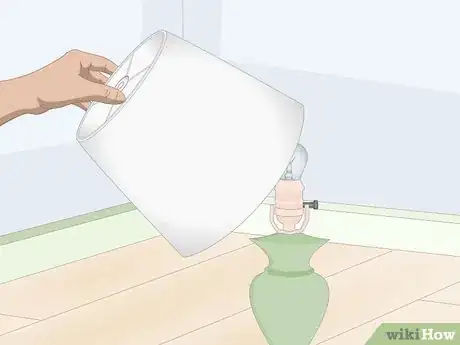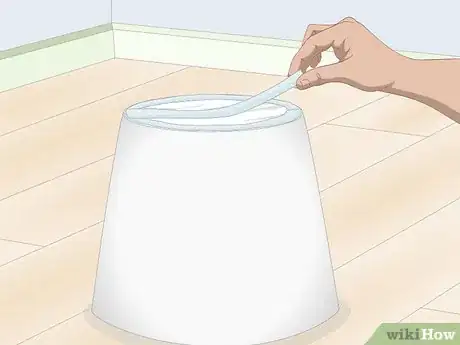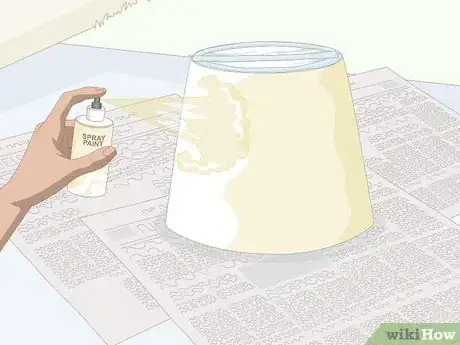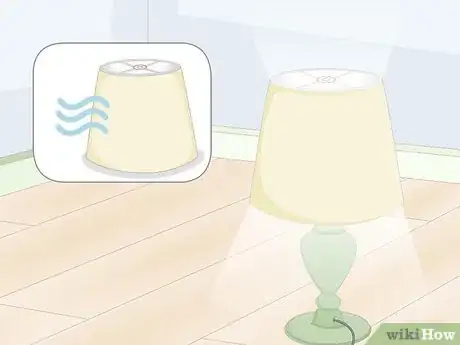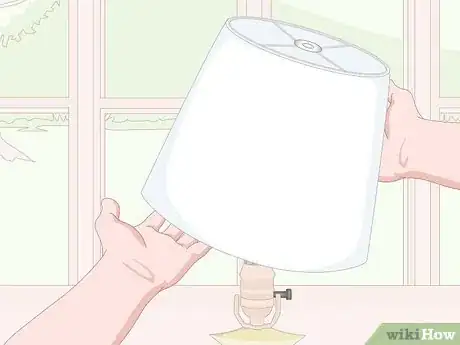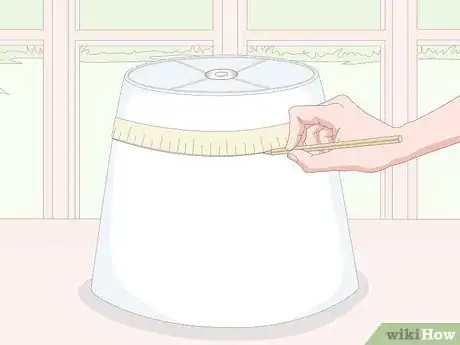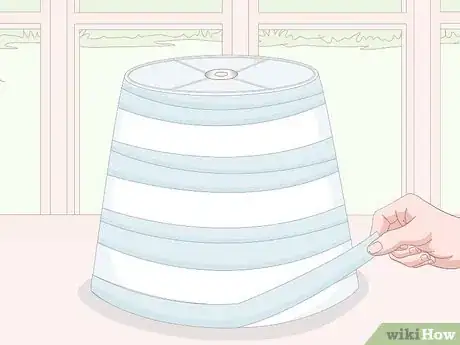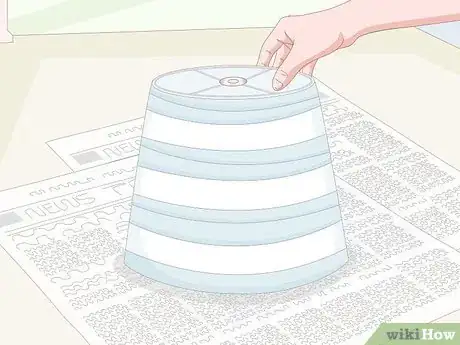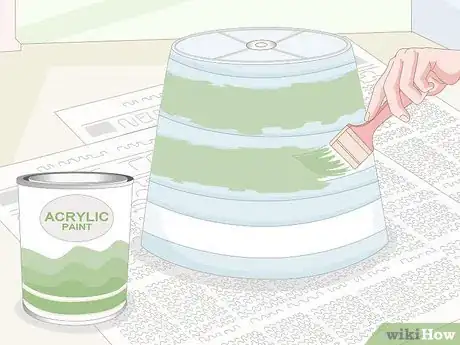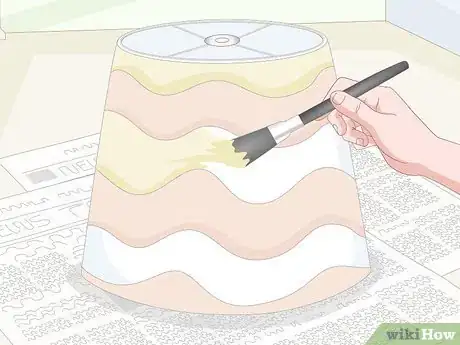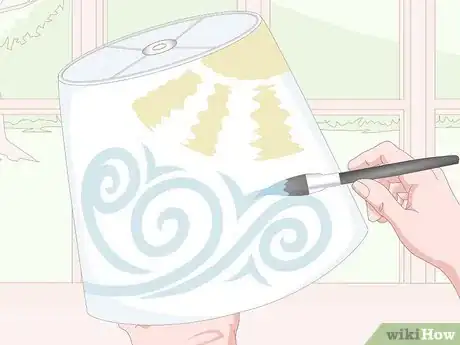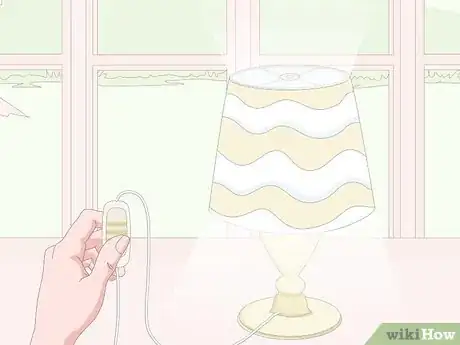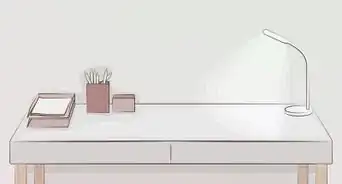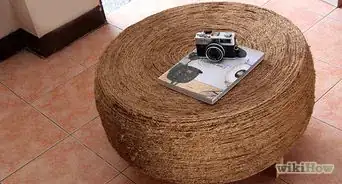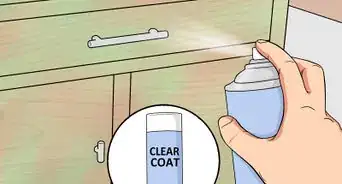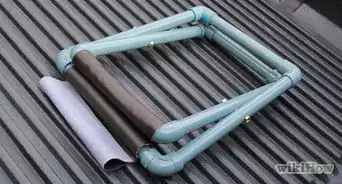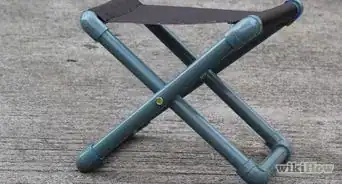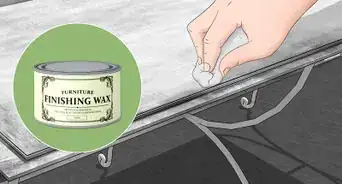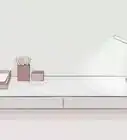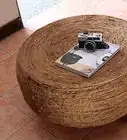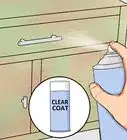This article was co-authored by wikiHow Staff. Our trained team of editors and researchers validate articles for accuracy and comprehensiveness. wikiHow's Content Management Team carefully monitors the work from our editorial staff to ensure that each article is backed by trusted research and meets our high quality standards.
There are 7 references cited in this article, which can be found at the bottom of the page.
This article has been viewed 105,030 times.
Learn more...
Painting a lampshade is an easy way to revamp an old shade or give it a new look to match your home decor and change the feeling of a room. Quickly give a lampshade a new coat of color with a can of spray paint or a paintbrush and paint of your choosing. Use paint to add stripes and other designs to a lampshade. Either way, all you need are a few art supplies to create a brand new lampshade for your home in just a couple of hours!
Steps
Painting a Solid Base Coat
-
1Take the lampshade off of the lamp. Unscrew anything that is holding the lampshade in place and lift it off of the lamp. Many lampshades have a piece in the middle at the top that holds the lampshade onto the base of the lamp.[1]
- You might need to unscrew the light bulb to lift the lampshade off.
-
2Cover the top of the lampshade with plastic bags and tape. Place plastic grocery bags over any metal parts at the top of the lampshade. Tape the bags to the inside edge of the lampshade with masking tape or blue painter’s tape.[2]
- You could also cover everything with tape instead of using plastic bags, but it is easier to just cover the whole area with plastic, and then seal the edges to avoid getting spray paint on parts that you don’t want to paint.
- You can tape designs onto the lampshade if you want to create a pattern instead of just a single shade all over. Try a zig-zag pattern, for example.[3]
Advertisement -
3Lay out some old newspapers or other paper on a flat work surface. Pick a flat work surface like a work table, a garage floor, or the ground outside. Put down old newspapers or regular paper in 2-3 layers to cover the area and protect it from spray paint.[4]
- Work in a ventilated area when you use spray paint. A work area outside or near open doors and windows is the best option.
-
4Place the lampshade on the covered work surface. Put the lampshade in the middle of the paper you laid down. Add more paper around the sides if the lampshade is closer than 1 ft (0.30 m) to the edges of the covered work area.[5]
- There is still a chance that the paint can drift outside of the covered area when you spray it, so it’s best not to use nice furniture like a dining room table as your work surface, and avoid spraying near other objects you wouldn’t want to get paint on.
-
5Spray the lampshade all over in an even coat. Take off the top of the spray paint can and hold it about 6 in (15 cm) away from the lampshade. Aim the nozzle at the lampshade and press it down to spray on the paint. Spray all over the lampshade until you have an even coat.[6]
- Work in the same direction as you spray to apply the coat of paint evenly. For example, work top to bottom or left to right.
- Lighter colored spray paints work best so that the light can still shine through the shade.
- Acrylic spray paint works best to paint any type of lampshade.
-
6Let the lampshade dry, then attach it to the lamp and turn it on. Let the lampshade sit for at least 1-2 hours until it is completely dry. Put it back on the base of the lamp, screw the lightbulb back in if you took it off, and turn the lamp on. Take it off and add another coat of paint if there are any uneven spots or if you are not happy with how it looks yet.[7]
- If the shade looks splotchy, then you need to apply another coat of paint. Apply the 2nd coat in the same direction as the 1st.
-
7Paint the shade by hand with a paintbrush if you want to avoid using spray paint. Prepare the lampshade and your work area the same way as you would for spray paint. Put some acrylic, chalk, or fabric paint in a paint tray or plastic cup and use a small flat paintbrush to apply an even coat to the shade.[8]
- Use long, straight up and down brush strokes to coat the lampshade evenly. Test the lampshade on the lamp once the paint is dry and apply more coats until you are happy with the finished look.
- Using chalk paint will give the finish an aged, chalky appearance. You can experiment by watering it down a bit to give the finish different looks.
- Acrylic paint will give your lampshade the most solid looking coat.
- Fabric paint is similar to acrylic paint, but it will have a less stiff-looking finish since it is designed specifically to soak into fabric easily.
Brushing on Stripes and Other Designs
-
1Detach the lampshade from the lamp. Unscrew the lightbulb and any other pieces that are holding the lampshade in place. Lift the lampshade off and set it down on a flat surface.[9]
- Set aside the lightbulb and any other screws or pieces of the lamp that you took off in a safe place until you put the shade back on.
-
2Use a flexible tape measure and a pencil to measure and mark out the stripes. Use a vinyl tape measure that can wrap around the lampshade. Decide how you want to space your stripes and make a mark at every interval with a pencil.[10]
- You can tape the end of the measuring tape to the shade with a piece of painter’s tape or masking tape to make it easier to hold in place.
- The kind of tape measure that tailors use is the best for measuring around the lamp.
-
3Tape over the areas between stripes that you don’t want to paint. Completely cover the areas that you want to leave the original color with painter’s tape or masking tape. Fold the tape over the edges at the top and bottom of the lampshade to protect them.[11]
- Painter’s tape and masking tape are available in different widths. You can use different sizes of tape to cover larger and smaller areas, or to create stripes of different widths.
- For tapered lampshades, you may want to trim the tape so it also comes to a tapered point at the top.
-
4Cover a flat work surface with old newspapers or other paper. A table or desk that you will be able to sit down at is the best work surface for painting a lampshade by hand. Lay out 2-3 layers of old newspapers or normal paper to completely cover the surface.[12]
- Since you will be using acrylic paints that are meant for indoor use, you don’t need to worry about working in a ventilated area. These paints are meant for art projects and other indoor projects.
-
5Put the lampshade on top of the newspapers or paper. Place the shade in the middle of the covered work area. Rotate it so that whatever stripe you want to paint first is facing you.[13]
- It will be easiest to paint in a well-lit area. Try to paint during the day when there is natural light, or make sure you have plenty of bright artificial light.
-
6Use a flat paintbrush and acrylic paints to paint the stripes. Squeeze out some of the acrylic paint color you want to use onto a paper or plastic plate, or into a paper or plastic cup. Use a flat brush that is at least 1 in (2.5 cm) wide to fill in the stripes with even up and down strokes.[14]
- You could also use specialized fabric paint that is available at craft stores for fabric lampshades.
- Acrylic paint will work on lampshades made of any material.
- Get paintbrushes of different widths if you want to make different sizes of stripes easily.
- Keep in mind that lighter colors will allow more light to shine through the lampshade.
-
7Mask off different geometric patterns instead of stripes for different looks. Use masking tape or blue painter’s tape to make zig-zags, Xs, hexagons, or just random patterns on the lampshade. Paint the areas inside or outside the tape with a small flat paint brush and acrylic paint to create your designs.[15]
- You can use chalk paint to create a more distressed, aged look.
- Fabric paint is another paint option similar to acrylic, but will soak into the fabric more.
-
8Use stencils instead of tape to paint on more complex designs. Draw any design you want on a piece of paper and carefully cut it out with scissors or a utility knife to create a stencil. Tape the stencil to the lampshade and dab paint of your choosing onto the shade with a stencil brush.[16]
- You can also buy stencils at an art store or print out designs to cut out.
- A stencil brush has a flat, round tip for dabbing paint on rather than brushing it on. This helps prevent bleeding and keeps the paint within the lines of your stencil.
-
9Sketch a design in pencil and paint over it, or free-hand paint a design. Use a pencil to draw any design you can imagine onto the lampshade. Paint over the design with a small paintbrush and the paint of your choosing.[17]
- It may help to have a variety of paintbrushes in different sizes, depending on how intricate your design is.
- Think of your lampshade as a coloring book. You can draw on intricate geometric patterns like mandalas or anything else that you think will be fun to paint!
-
10Attach the lampshade to the lamp once it is dry and turn the lamp on. Let the paint dry for at least 1-2 hours until it is totally dry to the touch. Place it back onto the base of the lamp and turn the lamp on to see if you need to add another coat of paint.[18]
- Check for spots all around the shade where the light shines through and makes it look blotchy. If you see any, take the shade off and add another coat of paint until you are happy with how it looks.
Things You’ll Need
Spray Painting a Lampshade
- Lampshade
- Plastic bags
- Masking tape or painter’s tape
- Newspapers or other paper
- Can of spray paint
- Flat paintbrush and acrylic, chalk, or fabric paint (optional)
Adding Stripes and Other Designs
- Lampshade
- Flexible measuring tape
- Pencil
- Stencils
- Masking tape or painter’s tape
- Newspapers or other paper
- Flat paintbrush
- Acrylic paints
- Chalk or fabric paints (optional)
- Paper and pencil (optional)
References
- ↑ https://kaseytrenum.com/diy-lamp-shade-revamp/
- ↑ https://kaseytrenum.com/diy-lamp-shade-revamp/
- ↑ https://www.bobvila.com/articles/diy-lampshades/
- ↑ https://kaseytrenum.com/diy-lamp-shade-revamp/
- ↑ https://kaseytrenum.com/diy-lamp-shade-revamp/
- ↑ https://kaseytrenum.com/diy-lamp-shade-revamp/
- ↑ https://kaseytrenum.com/diy-lamp-shade-revamp/
- ↑ https://wheelchichome.com/2017/09/18/how-i-revamped-a-lampshade-with-chalk-paint/
- ↑ https://www.housebeautiful.com/uk/decorate/looks/videos/a602/quick-and-easy-decorating-project-paint-your-own-lampshade/
- ↑ https://www.housebeautiful.com/uk/decorate/looks/videos/a602/quick-and-easy-decorating-project-paint-your-own-lampshade/
- ↑ https://www.housebeautiful.com/uk/decorate/looks/videos/a602/quick-and-easy-decorating-project-paint-your-own-lampshade/
- ↑ https://www.housebeautiful.com/uk/decorate/looks/videos/a602/quick-and-easy-decorating-project-paint-your-own-lampshade/
- ↑ https://www.housebeautiful.com/uk/decorate/looks/videos/a602/quick-and-easy-decorating-project-paint-your-own-lampshade/
- ↑ https://www.bobvila.com/articles/diy-lampshades/
- ↑ https://www.thekimsixfix.com/2016/09/how-to-customize-lampshade-with-paint.html
- ↑ https://www.royaldesignstudio.com/blogs/stenciling-tips/diy-lampshade-stencils-tutorial
- ↑ https://www.houseandgarden.co.uk/article/hand-painted-lampshade-diy-how-to-arts-craft
- ↑ https://kaseytrenum.com/diy-lamp-shade-revamp/
